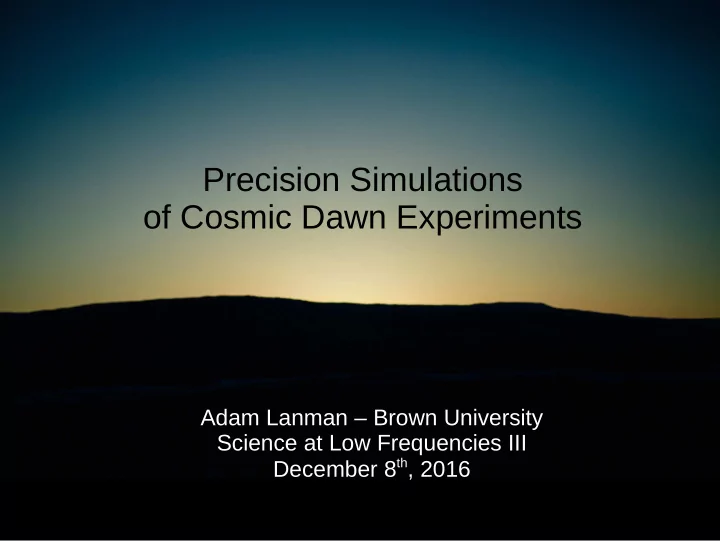

Precision Simulations of Cosmic Dawn Experiments Adam Lanman – Brown University Science at Low Frequencies III December 8 th , 2016
EoR vs. Foregrounds ● Foregrounds (radio galaxies, SNRs, galactic synchrotron, thermal bremsstrahlung, etc.) are typically 10 5 x brighter than the expected EoR signal.
Coordinates ● Visibility coordinates correspond with spatial coordinates: – u is already in Fourier space. – Frequency corresponds with distance, so its Fourier dual (η) corresponds with k || . Comoving distance
Foreground Avoidance ● Smooth-spectrum foregrounds will go to low k || , while the complicated spectrum of the EoR will appear at high k | ● Instrument chromaticity will throw some power to higher k || into a characteristic wedge shape.
PAPER128 MWA Phase II HERA19 ● Murchison Widefield Array ● Precision Array for Probing the Epoch of Reionization ● Hydrogen Epoch of Reionization Array
MWA Data Analysis ● Preprocessing – Raw correlator output is reformatted and flagged for RFI contamination. ● Calibration, forward-modeling, and imaging are all done in FHD. ● eppsilon does power spectrum estimation
Fast Holographic Deconvolution (Convolution) (Gridding) Holographic mapping function
Fast Holographic Deconvolution Weights Cube Beam Model Beam Model Beam Model ● The baseline positions and a saved antenna beam model are used to construct a point spread function for the array. – Beam models are made using electromagnetic simulations. ● The beam model is used to construct and then grid model visibilities based on a source catalog. ● The model visibilities are used for calibrating the raw visibilities from the data file.
FHD as instrument simulation Weights Cube Beam Model Beam Model ● All that's needed to generate the model visibilities is a set of baseline coordinates, a beam model, and a source catalog. ● EoR signal, diffuse emission, and noise can also be included.
Simulating EoR ● FHD may be used to simulate an EoR signal. ● Gaussian Sky – Generate random brightness fluctuations on a sky with a given power spectrum. ● Bubble Simulation – Tile a cube from a εppsilon results of an EoR simulation using the MWA128 configuration. Red is the input 21cmFAST simulation. EoR signal, and blue/black are the signal recovered from the instrument.
PAPER Pipeline Figure adapted from Ali, et al. (2015) ● A quadratic estimator is used to calculate the power spectrum. ● This can include inverse covariance weighting and windowing. ● Errors are estimated by bootstrapping – Select random subsamples of the visibilities and repeat PS estimation.
Simulations ● Tests with a single 100m east-west baseline. – PAPER beams vs. MWA beams. – Adjusting simulation and phasing parameters. ● 9 hours worth of data from PAPER128 – Julian Dates 2456535.333 to 2456535.708 – RA = 0 crosses the zenith about halfway through. ● 9 hours worth of data from HERA19
PAPER128 Results Logarithmic waterfall plot of a single baseline. 10,000 GLEAM catalog sources simulated, with no added noise or EoR signal. The increased power later on is due to Fornax A entering the beam.
PAPER128 Results (Horizon line)
HERA19 Results
“Unfortunate Lines” ● Delay-transformed waterfall plots of FHD-simulated data show excess power at high delays. ● This seems to be due to the resolution of the gridding kernel. The top half shows data simulated with uv resolution of 0.5 λ. The bottom has resolution 0.1λ. Both are for HERA19 on an 81 m baseline with 300 sources, same times. (Lines are not present in actual data)
File Edges ● FHD only calculates the primary beam once per snapshot. Measured brightness of sources changes over time as sources move through the beam. ● Simulated visibilities show distinct “jumps” between files as a result of this. ● This is especially obvious with only one Single 100m east-west baseline with a single source. 100Jy source approaching the zenith.
Rounding Errors ● Snapshots are phased to zenith at a given time step. – Discontinuities appear at these times. ● This came up when phasing data with the pyuvdata package. ● Investigating this error, we uncovered a bug in how FHD handles small uvw coordinates. 300 sources, simulated for a 100m east-west baseline and MWA beams.
Summary ● FHD's forward-modeling feature may be used for standalone instrument simulation. ● Simulated data from PAPER128 and HERA19 have been processed using the PAPER power spectrum pipeline. ● Generating raw visibilities with FHD has revealed processing artifacts that must be understood.
Recommend
More recommend